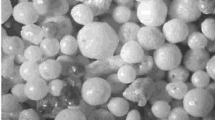Abstract
Microspheres are currently a very important raw material mixture component for production of high-quality thermal insulating refractory materials with low bulk density. At present there are several sources of microspheres on the market. Although the price range of offered microspheres is not wide, their quality varies greatly. It is therefore necessary to examine the influence of various brands of microsphere on the thermal insulation properties of refractory materials. The aim of this paper is to describe the basic properties of available microspheres (grain size di7stribution, powder density, loss on ignition, chemical analysis) and determine their impact on the properties of dry-pressed bodies (bulk density, coefficient of thermal conductivity, firing shrinkage, Pyrometric Cone Equivalent (PCE) and microstructure). The results show significant differences in the ability of individual test microspheres to produce a body with low thermal conductivity and high refractoriness according to PCE testing.
Similar content being viewed by others
References
ASTM C618 12a, Standard specification of coal fly ash and raw calcined natural pozzolan for use in concrete
Fečko, P., Kušnierová, M., Raclavská, H., Čablík, V., Lyčková, B.: Fly Ash. Technical University of Ostrava, Ostrava (2005)
Fei Qi, Xingxing Xu, Jie Xu, Yali Wang, Jinlong Yang: A Novel Way to Prepare Hollow Sphere Ceramics. J. Am. Ceram. Soc. 97 (2014) [10] 3341–3347
Lou Hongfei, Wang Jianjiang, Huo Xingjian, Cai Xudon: Preparation and mechanism analysis of a new type hollow multiphase ceramic micro-spheres. Powder Tech. 215–216 (2012) 72–78
Sokolář, R., Nevřivová, L.: Microspheres-properties, utilization, sources (in Czech). Keram. zprav. 20 (2004) [8] 4–6
Xiao-Yan Z., Tian Lanb, Na Lic, Jia-Min Wud, Wen-Long Huoa, Ning Maa, Jin-Long Yanga: Porous silica ceramics with uniform pores from the in-situ foaming process of silica poly-hollow microspheres in inert atmosphere. Mater. Lett. 182 (2016) [1] 143–146
Na Lia, Xiao-Yan Zhang, Ya-Nan Q, Jie Xu, Ning Ma, Ke Gan, Wen-Long Huo, Jin-Long Yang: A simple and efficient way to prepare porous mullite matrix ceramics via directly sintering SiO2-Al2O3 microspheres. J. Eur. Ceram. Soc. 36 (2016) [11] 2807–2812
Author information
Authors and Affiliations
Corresponding author
Rights and permissions
About this article
Cite this article
Sokolář, R. The Effect of Microspheres on the Properties of Thermal Insulating Refractory Materials. Interceram. - Int. Ceram. Rev. 66, 22–27 (2017). https://doi.org/10.1007/BF03401225
Received:
Published:
Issue Date:
DOI: https://doi.org/10.1007/BF03401225




